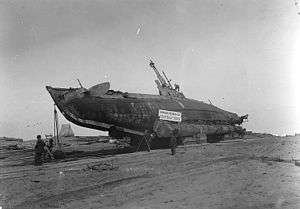USS H-3 (SS-30)
 USS H-3 underway, circa 1922 | |
| History | |
|---|---|
| Name: | USS H-3 |
| Builder: | Moran Bros., Seattle, Washington |
| Laid down: | 3 April 1911, as Garfish |
| Launched: | 3 July 1913 |
| Commissioned: | 16 January 1914 |
| Decommissioned: | 23 October 1922 |
| Renamed: | H-3, 17 November 1911 |
| Struck: | 18 December 1930 |
| Fate: | Sold for scrap, 14 September 1931 |
| General characteristics | |
| Type: | H-class submarine |
| Displacement: |
|
| Length: | 150 ft 4 in (45.82 m) |
| Beam: | 15 ft 10 in (4.83 m) |
| Draft: | 12 ft 5 in (3.78 m) |
| Installed power: |
|
| Propulsion: |
|
| Speed: |
|
| Test depth: | 200 ft (61 m) |
| Complement: | 25 officers and men |
| Armament: | 4 × 18 in (460 mm) torpedo tubes (8 torpedoes) |
USS H-3 (SS-30) was a H-class submarine originally named Garfish, the only ship of the United States Navy named for the garfish, a popular target for recreational anglers.
Garfish was laid down by Moran Bros. in Seattle, Washington. She was renamed H-3 on 17 November 1911, launched on 3 July 1913 sponsored by Ms. Helen MacEwan, and commissioned at Puget Sound on 16 January 1914, Lieutenant, junior grade William R. Munroe in command.
Service history
After shakedown, H-3 was attached to the Pacific Fleet and began operations along the coast from lower California to Washington, exercising frequently with H-1 and H-2.
H-3 ran aground in heavy fog while attempting to enter Humboldt Bay on the morning of 16 December 1916. The crew were rescued by Coast Guard Humboldt Bay Life-Saving Station; many were brought to shore by breeches buoy. Storm surf pushed H-3 high up on a sandy beach, surrounded by quicksand. At low tide, she was 75 ft (23 m) from the water, but at high tide, the ocean reached almost 250 ft (76 m) beyond her. The submarine crew pitched camp on the Samoa, California beach near their stranded submarine, while the tug Iroquois steamed from Mare Island Navy Yard to attempt salvage.[1] Combined efforts of Iroquois and Cheyenne were unable to dislodge H-3, so both ships returned to Mare Island while the Navy requested bids from commercial salvage firms. Only two bids were received. The largest marine salvage firm on the west coast offered to pull the submarine into deep water offshore for $150,000 and the Mercer-Fraser Company of Eureka offered to pull the submarine over the Samoa peninsula into Humboldt Bay for $18,000.[1]

Navy officials at Mare Island regarded the lumber company proposal as infeasible and felt the salvage firm bid was excessive. The protected cruiser Milwaukee sailed from Mare Island to tow H-3 off the beach. Milwaukee grounded attempting salvage on 13 January 1917 and broke up in the pounding surf.[2]
H-3 was temporarily decommissioned on 4 February while the lumber company salvage bid was accepted. H-3 was placed on giant log rollers and taken overland to be relaunched into Humboldt Bay on 20 April.
She then returned to San Pedro, California, where she served as flagship of Submarine Division 7 (SubDiv 7), participating in exercises and operations along the coast until 1922. H-3, with the entire division, sailed from San Pedro on 25 July and reached Hampton Roads on 14 September.
H-3 decommissioned at Hampton Roads on 23 October. She was struck from the Naval Vessel Register on 18 December 1930 and scrapped on 14 September 1931.
References
- This article incorporates text from the public domain Dictionary of American Naval Fighting Ships. The entry can be found here.
- Haislip, Harvey, CAPT USN (February 1967). "The Valor of Inexperience". United States Naval Institute Proceedings.
External links
- Photo gallery of USS H-3 at NavSource Naval History
- Photos and description of salvaging the sub from the U.S. Navy military archives
- Salvaging the Submarine H-3' International Marine Engineering, September 1917, technical article on bids and work.